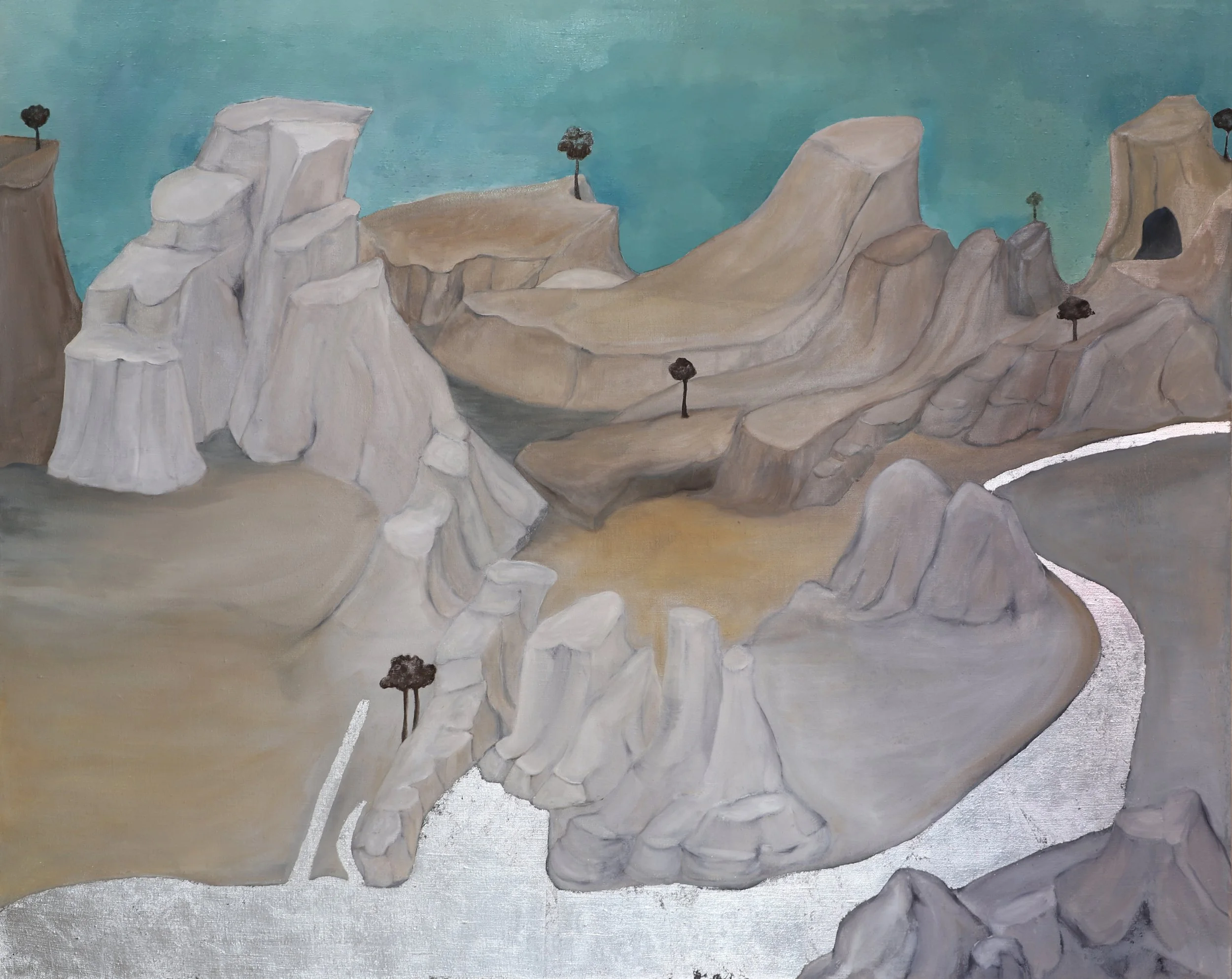Transformative Wilderness.
Henrietta Simson
Material Culture (1) is constructed out of porcelain paper clay and decorated with the traditional cobalt blue patterns that have travelled around the world in the form of the ceramic tile. From China to Turkey, to Europe and the Americas, these patterns have adapted, taking on local cultural identities – mutations driven by colonialism and global trade. The mountain form itself is also a kind of mutation, fusing Cornish waste heaps with the craggy outcrops of the painting of medieval Italy; its shape derived from both industrial and spiritual wilderness landscapes. It sits on a thin pewter plate, which produces a rippled reflection suggesting water and the flow of goods and ideas across the globe via rivers and seas.
The questions that inform this work focus on what these early paintings of landscape can mean today. As places that signify spiritual transformation, can they help to redefine the language that surrounds the mine, to shift the way we perceive it and its significances? Can an engagement with these early images help to integrate the industrial wilderness into our collective landscape imagination? An open-cast mine might be considered an ‘eye-sore’, a ‘blot on the landscape’, whether there is good or bad practice involved; its value measured (adversely) by the aesthetic constraints of traditional western landscape painting. The controversies that attach to mining often obscure the mine itself and we fail to value it and see its fundamental role in our lives. The work explores these challenges, drawing inspiration from attitudes to wilderness very far removed from our own.
The wilderness landscapes of medieval and early Renaissance painting were transformative spaces, associated as they were with visionary insight and change. Their features appeared to have mystical properties. Holy figures would atone within them, receiving divine wisdom in these remote and rocky sanctuaries. These were liminal spaces, unconnected to the rhythms of circadian time, places where the boundaries between dreaming and waking became blurred. Thought of as wounds and associated with healing, their caves and hollows nurtured the spiritual while sustaining the material dimensions of life. Like portals, they linked the deepest, darkest recesses of the Earth to the heavenly sphere above. And the non-naturalistic style of these wilderness landscapes’ depiction affirms this connection of body and spirit, for in spite of their spiritual associations their features are wholly suggestive of the material body. These are spaces very far removed from contemporary ideas of landscape. They are not characterised by a pleasing ‘view’, nor was their value measured in terms of the world of work – a place to go to restore the spirits in order to ready one for work again. Their scenery of rocky, barren outcrops, craggy mountains and caves doesn’t function within the confines of capitalist production, with its work-life balance and the rational ordering of time and experience. Their cliffs and crevices – suggesting bony, abstinent bodies – appeal to a different sense of time and space. As depictions of landscape whereby the earth’s ‘body’ is brought more in line with our own human bodies, they inspire empathy and a perception not based on any aestheticised view that acts as the backdrop to our leisure activities.
By moving away from this idea of landscape as an imaginary diversion from the reality of work and everyday life, we can begin to reshape our attitude to the mine. Industrial wilderness is not considered a visually appealing place, and the traditional western landscape aesthetic obscures our ability to see any landscape that diverges from its code – even those places of industry needed to avert the existential crises of the 21st century. But we can reclassify the mine and bring it into the positive realm that other landscapes enjoy in our collective imagination. Seen through the medieval wilderness, the mine becomes a transformative space, where its material and spiritual impacts are brought to life. It becomes accepted into our frames of reference. As the blue tiles show, materials and visual forms are in continuous circulation. Cultural difference is just another point along a trade route which supports the flow of materials in our globalised systems. By engaging with the industrial wilderness – with the mine – as ‘landscape’, we can re-cast its image.
Of Earth For Earth (2020)
HENRIETTA SIMSON
Henrietta Simson is an artist whose work explores the landscape image through its historical and cultural development, and its current definition within a digital context framed by ecological crisis. Drawing from late medieval and early Renaissance imagery, she presents an idea of landscape that challenges its designation within human/nonhuman dichotomies and that facilitates a critical questioning of the visual structuring of space. She completed an MA at the Slade School of Fine Art in 2007, and a practice-related PhD in 2017: Landscape After Landscape, Pre-Genre Backgrounds in a Post-Genre Digital Age.
After Thebaid, 2020, 120 x 150 cm, oil and metal leaf on linen


